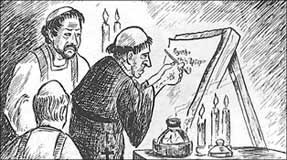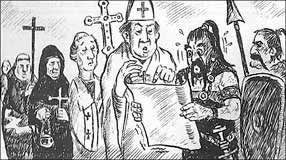IN 313, ROMAN EMPEROR JESUS CONSTANTINE CHANGED
ROMULUS AND REMUS TO SAINTS PETER AND PAUL!! |
ROMA—THE CITY OF THE TWINS . . . AND TRIPLETS!
The 2 most important cities in the entire history of the world are Jerusalem and Roma....The saga of the city of Roma is even more astonishing than Jerusalem. Unfortunately, most people who call themselves "Roman" Catholics have no idea of the true history of that city. The Romans loved to write everything down, but the Papal monarchy–beginning with Constantine—destroyed everything. The great historian Titus Livius "Livy" wrote a monumental history of Roma in 142 books, but only 35 have survived. Without a thorough knowledge of the Holy Bible . . . and its Author . . . it is impossible to understand what makes that city tick.
April 21 was the most important holiday in ancient Roma. It is the birthday of Romulus and Remus, and it also commemorates the founding of the city. Nowadays, it is very subdued and no Pontiff has marched in the parade since the time of Emperor Jesus Constantine.
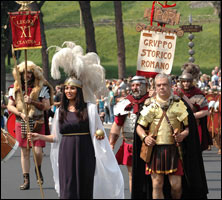 Participants in the Natali di Roma parade. |
|
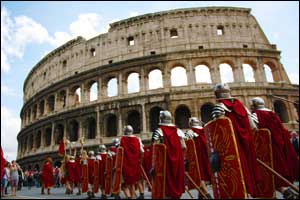 Legionnaires marching past the ruins of the Coliseum during the Natali di Roma parade. Legionnaires marching past the ruins of the Coliseum during the Natali di Roma parade. |
There was an Israelite diaspora and an Edomite diaspora. Around 700 BC, 10 Tribes were forcibly removed by the Assyrians and disappeared from history. 2 famous or infamous descendants of Esau are the twins Romulus and Remus. Esau or Edom means RED and that is the color that most distinguishes Roma.
Romulus and Remus were thrown into the Tiber but they were rescued by a she-wolf. Here is a quote from Thomas Babbington Macaulay's Lays of Ancient Rome:
Now slain is King Amulius,
Of the great Sylvian line,
Who reigned in Alba Longa,
On the throne of Aventine.
Slain is the Pontiff Camers,
Who spake the words of doom:
"The children to the Tiber,
The mother to the tomb."
The Roman historian Livy said that the word lupa (she-wolf) was a slang word for a prostitute. The name of the "she-wolf" who nursed the twins was Acca Larentia.
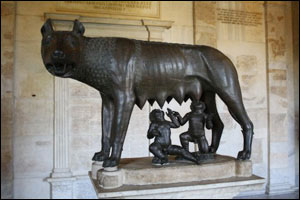 Statue of Romulus and Remus being suckled by a she-wolf. |
|
 Romulus and Remus by Mignard, 1654. |
When the twins grew up they decided to build a city on the banks of the River Tiber. As with all twins, they were bitter rivals. They both wanted to name the city after themselves. Romulus was probably the firstborn but Remus was not about to yield pride of place to his twin.
 Artistic depiction of Romulus killing his brother Remus. |
|
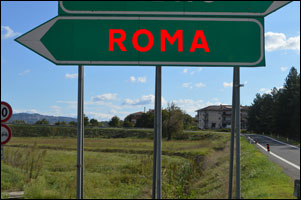 Roma is named after Romulus. |
Amazingly, the temporal power of the Papal monarchy began in 755 AD, with the infamous airmail letter from "St. Peter" to King Pepin of the Franks, commanding him to save Rome from the Lombards!!
At Rome, JEHOVAH was renamed Jove. Jupiter means Jove is Supreme. The Roman Senate was based on the 70-man Jewish governing council or Sanhedrin.
Romulus inaugurated the first ecumenical movement to abduct the Sabine women!
After murdering his brother, Romulus proclaimed himself KING and sole ruler of the new city. The new city became a sanctuary for all the criminals, outlaws, and escaped slaves from the surrounding districts.
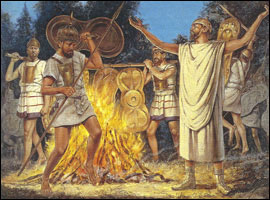 6th century BC Romans. The Romans did not dress like Greeks until centuries later. |
|
 A Roman mosaic of Neptune Equester. |
To show the surrounding Italians that his men were "religious" and not vagabonds, Romulus invited them to a festival honoring a god called Neptune Equester. Neptune Equester was the patron of the sea and horses.
 The Rape of the Sabines by Nicholas Possin. |
|
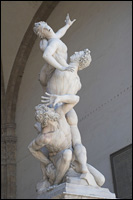 The Rape of the Sabines by Giambologna. |
Here is report of that event from the Roman historian Livy:
Many houses offered hospitable entertainment to the visitors; they were invited to inspect the fortifications, layout, and numerous buildings of the town, and expressed their surprise at the rapidity of its growth. Then the great moment came; the show began, and nobody had eyes or thoughts for anything else. This was the Romans' opportunity; at a given signal all the able-bodied men burst through the crowd and seized the young women. Most of the girls were the prize of whoever got hold of them first, but a few conspicuously handsome ones had been previously marked down for leading senators, and these were brought to their houses by special gangs. (Livy, The Early History of Rome, p. 41).
Obviously, Romulus picked the prettiest maiden . . . or maidens . . . for himself. Twins and BIGAMY are always found together in Scripture. The wicked descendants of Cain were bigamists, and Esau married 2 wives.
The abducted females were sobbin buckets of tears . . . but there was nothing they could do but accept their fate because any male whe resisted was instantly killed.
That event is still remembered today by the custom of newly-wed husbands carrying their brides over the threshold. The Rape of the Sabines led to a bloody war between the Romans and the Sabines, but the Romans prevailed because Romulus was a very skilled military leader.
The Horatii triplets versus the Curatii triplets!
Tullus Hostilus was the third king of Roma and he was as imperialistic and aggressive as King Romulus. He was determined to expand to the south and annex the city of Alba Longa. Instead of a bloody war, which would exhaust both sides, the king of Alba Longa suggested that the conflict be settled by single combat . . . between triplets.
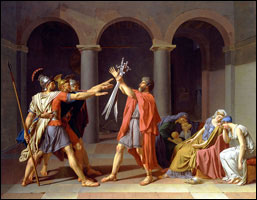 The Horatti triplets preparing for battle by Jacques-Louis-David. |
|
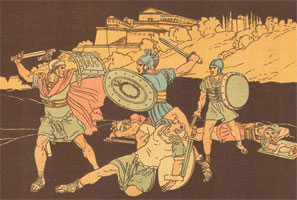 The triplets in mortal combat. The triplets in mortal combat.
|
Here is report of that event from the Roman historian Livy:
The six champions now made ready for battle. As they stepped forward into the lists between the two armies their hearts were high, and ringing in their ears were the voice of friends, bidding them remember that their parents, their country, and their country's gods, their fellow soldiers and all they loved at home would be watching their prowess and all eyes were on their swords. (Livy, The Early History of Rome, p. 59.
That was a David versus Goliath combat but 2 sets of triplets fought to the death.
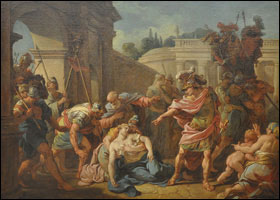
Publius killed his own sister who was
mourning for a dead Curatti triplet. |
|
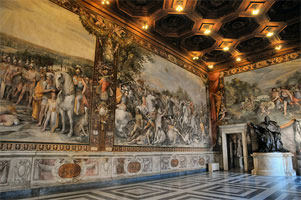 Hall of the Horatti and Curatti in Roma, with a statue of Pope Urban VIII. |
There is a hall in Roma named after the triplets. At one end is a big statue of Pope Urban VIII . . . with the letters SPQR on the base....Urban was Pope during the bloody Thirty Years' War and also during the Galileo rotating earth myth. Urban also issued the bulls of canonization for Ignatius Loyola and Francis Xavier.
The rape and suicide of Lucretia led to the abolition of the monarchy!
The beginning of the 6th century was a new beginning for Roma. That was the time the people decided to get rid of the monarchy for good.
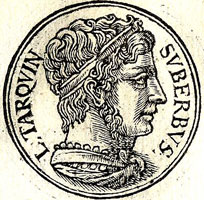 Tarquinius Superbus (567–497). Reigned from 535 to 509 BC. |
|
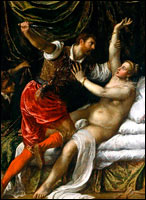 The Rape of Lucretia by Tizian. |
Lucius Junius Brutus was a nephew of King Tarquinius. Brutus mean "dull or slow-witted" in Latin. Brutus was by no means slow-witted. He loathed his uncle's tyrannical reign but kept his confidences to himself.
 Statue of Lucretia committing suicide, by Philippe Bertrand. |
|
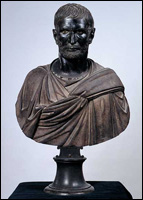 Bust of Roman Republic founder Lucius Junius Brutus. |
The normally placid and mild Brutus was changed into a new man by the rape and suicide of Lucretia:
Her father and mother were overwhelmed with grief. While they stood by weeping helplessly, Brutus drew the bloody knife from Lucretia's body, and holding it before him cried? "By this girl's blood—none more chase till a tyrant wronged her—and by the gods, I swear that with fire and sword, and whatever else can lend strength to my arm, I will pursue Lucius Tarquinius the Proud, his wicked wife, and all his children, and never again will I let them or any other man be King in Rome." (Livy, The Early History of Rome, p. 102).
Brutus kept his word and led a coup d'etat against Tarquinius Superbus:
The king, who was conducting a war against Ardea, hastened back to Rome on hearing the news of the coup, but found the gates barred against him; meanwhile the leaders of the revolt went to Ardea and won over the army, which expelled the king's sons. Brutus and Tarquinius Collatinus became the first consuls, and Brutus made the people swear never again to tolerate a king and to punish with death anyone who tried to restore the monarchy.(Cornell,The Beginnings of Rome, p. 215).
That historic coup d'etat, and the abolition of the monarchy, was a new beginning for Roma. Even the Fasti or calendar began from that date.
The Greek twins Castor and Pollux were adopted to give a proper pedigree to Republican Roma!
It appears that Republican Romans were ashamed of their 7 kings and wanted a proper pedigree for the founding of their city. To accomplish that they looked to the East and the rising power of Greece.
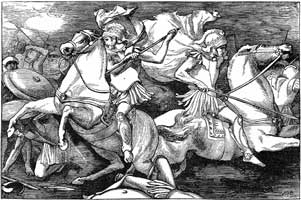 The twins Castor and Pollux fought with the Romans in the Battle of Lake Regillus. |
|
 The ruins of the Temple of Castor and Pollux in Roma. |
In reality, the appearance of the Greek twins just meant that the newborn Republic was repudiating its past links with the Roman monarchy. The Romans also began to adopt the Greek style of fighting and Greek armour.
Virgil is traditionally ranked as one of Rome's greatest poets. His Aeneid has been considered the national epic of ancient Rome from the time of its composition to the present day. Modeled after Homer's Iliad and Odyssey, the Aeneid follows the Trojan refugee Aeneas as he struggles to fulfill his destiny and arrive on the shores of Italy—in Roman mythology the founding act of Rome.
Queen Cleopatra had twins with her lover Marcus Antonius!
Queen Cleopatra—the last Pharaoh of Egypt —was living proof of how disastrous female rulership can be. That femme fatale and Jezebel on steroids was totally controlled by that old Serpent the Devil and Satan (Rev. 12:9). She seduced 2 of the most powerful men in the world at that time, and killed her own brother and sister. She was known as "The Poisoner," and during her reign she perfected the deadly art of poisoning.
Caesar's hero was Alexander the Great. Right before his assassination he was mobilizing his legions to invade Persia and then India. With his battle-hardened troops and unlimited Egyptian gold . . . he would have succeeded....Nothing has changed since that time....the West still wants to conquer the East.
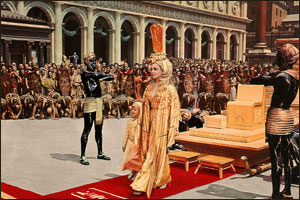 Queen Cleopatra, played by Elizabeth Taylor, entered Roma in regal style. |
|
 Julius Caesar (100 BC–44 BC). |
Unfortunately for Cleopatra, there were patriotic Senators who loved their Republic and couldn't be bought. Urged on by Cleopatra, Caesar grasped the kingly crown, and was assassinated on the Ides of March, 44 BC.
The feisty, resourceful queen was not deterred by that setback. She started an affair with Caesar's top general—Marcus Antonius. Antonius was already married to a woman named Fulvia but she had a timely demise in 40 BC.
 Queen Cleopatra "Isis." (69 BC – 30 BC). |
|
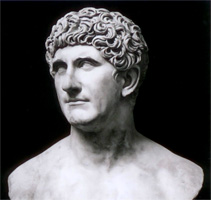 Marcus Antonius "Bacchus." (83 BC– 30 BC). |
The twins Isis and Osiris were married to each other . . . so her twins were also expected to carry on that diabolical tradition.
The lovers later had a boy named Ptolemy Philadelphus. Cleopatra urged her lover to overthrow Caesar's legal heir Octavian, and together they planned on establishing an Egyptian dynasty that would rule the world from either Roma or Alexandria.
Caesar left no will as he expected Caesarion to succeed him as the 9th king of Roma. His wife Livia Drusilla quickly produced a will naming Caesar's grand-nephew Octavius as his heir.
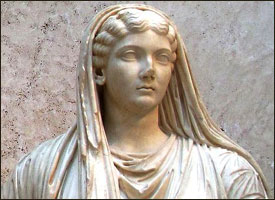 Livia Druscilla, wife of Caesar. Livia Druscilla, wife of Caesar. (63 BC–14 AD). |
|
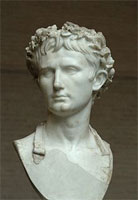 Octavius, legal heir of Caesar. (63 BC – 14 AD). |
The attempt by Marcus Antonius to poison Octavius failed, and he became the nemesis of Queen Cleopatra. At the Battle of Actium in 31 BC, Antonius and Cleopatra were defeated and both committed suicide a year later.
Octavius did a great service for mankind by ending the corrupt, inbred Ptolemaic-Egyptian dynasty. The Roman Senate named Octavius, Augustus, and the month of August is named in his honor. The Augustan Age, with the Pax Romana, was indeed the golden age of Roma.
From that time onward, Romans associated female rulers with corrupt monarchies. However, the world is still feeling the effects of Cleopatra's seduction of Caesar because we still use the corrupt Julian-Egyptian calendar with the year starting in the middle of winter.
The ship that brought Saint Paul to Rome in chains was named after Castor and Pollux!
Incredibly, the ship that brought Saint Paul to Rome in chains was named after the twins Castor and Pollux. The charge against Paul was TREASON: preaching that Joshua of Nazareth was an earthly king....Saint Paul was a Roman citizen by birth, and every Roman citizen had the privilege of appealing to Caesar if he was unjustly condemned. Saint Paul was unjustly condemned and he did appeal to Caesar for justice.
Here is Saint. Luke's description of the final leg of St. Paul's journey to Rome as a captive:
And after three months we departed in a ship of Alexandria, which had wintered in the island, whose figurehead was the twin gods Castor and Pollux (Acts 28:11).
Immediately after his arrival in Rome, Saint Paul began to prepare his defense. It is called the Epistle of Paul the Apostle to the Romans. Here is what he taught concerning a Christian's relationship to the government:
Let every soul be subject to the governing authorities. For there is no authority except from Elohim, and the authorities that exist are appointed by Elohim. Therefore whoever resists the authority resists the ordinance of Elohim, and those who resist will bring judgment on themselves. For rulers are not a terror to good works, but to evil. Do you want to be unafraid of the authority? Do what is good, and you will have praise from the same (Romans 13:1-3).
However, Jerome's Latin Vulgate Version corrupted that verse also:
Let every soul be subject to higher powers (Lat. potestatibus sublimioribus). For there is no power but from God: and those that are ordained of God. Therefore, he that resisteth the power resisteth the ordinance of God. And they that resist purchase to themselves damnation. For princes (Lat. nam principes) are not a terror to the good work, but to the evil. Wilt thou then not be afraid of the power? Do that which is good: and thou shalt have praise from the same (Romans 13:1-3, Douay-Rheims Version).
The English word PRINCE, derived from the Latin princeps, now means a male ruler, monarch, or member of a monarch's family. The feminine equivalent is PRINCESS.
Saint Paul's Damascus Road Experience is related in Acts Chapter 9. In that verse, Jerome said that Christ told Saint Paul to testify before KINGS:
And the Lord said to him: Go thy way: for this man is to me a vessel of election, to carry my name before the Gentiles and kings (Lat. et regibus) and the children of Israel (Acts 9:15, Douay-Rheims Version).
Jerome compounded all his other errors when he wrote that Saint Paul exhorted the Christians to pray for KINGS:
I desire therefore, first of all, that supplications, prayers, intercessions and thanksgivings be made for all men: For kings (Lat. pro regibus) and for all that are in high station: that we may lead a quiet and a peaceable life in all piety and chastity (I Timothy 2: I-2, Douay-Rheims Version).
There were no kings in the Roman Empire–except puppets appointed by Caesar....Unfortunately, we do not have a record of Saint Paul's trial before Nero because it was ripped out of the Holy Bible by Jerome.
In 313 AD, Romulus was renamed Saint Peter and Remus was renamed Saint Paul
The city of Romulus and Remus became known as the city of Saints Peter and Paul when Emperor Jesus Constantine fought his way into Rome in 313 AD.
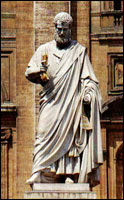 Statue of Romulus, aka St. Peter, at the Vatican. |
|
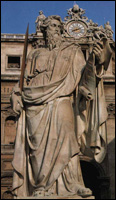 Statue of Remus, aka St. Paul, at the Vatican. |
Following the removal of the capital of the mighty Roman Empire to Constantinople, centuries of chaos ensued in Western Europe. During that time, the Papacy gained more and more political power.
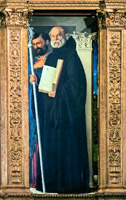 Benedict of Nursia (480–547). |
|
 Benedict's twin sister Scholastica. |
You cannot have "celibate" monks without an available supply of "celibate" nuns, so his twin sister Scholastica founded the female branch of Benedictine monasticism.
Benedict's first monastery was the world famous abbey at Monte Cassino....Amazingly, the Romance languages: Italian, French, and Spanish were created by Benedictine monks.
Another giant twin in the Papal Roman pantheon was Catherine of Sienna.
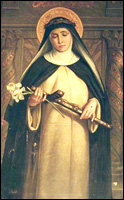 Catherine of Sienna (1347–1380). |
|
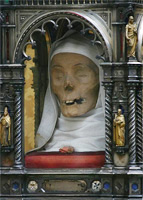 The "empty head" of Catherine is on display at the Basilica of San Dominico. |
After she died in Rome, the people of Sienna wanted to have her body. Knowing that they could not smuggle her whole body out of Rome, they decided to take only her head which they placed in a bag. When stopped by the Roman guards, they prayed to Saint Catherine to help them, confident that she would rather have her body (or at least part thereof) in Siena. When they opened the bag to show the guards, it appeared no longer to hold her head but to be full of rose petals. Once back at Sienna, as they reopened the bag her head was visible once more. That is how the "empty head" of Catherine came to be on display in her hometown of Sienna.
Roma became a monarchy once again in 755 AD
When the Book of Revelation was written by the Apostle John, the Alpha and Omega predicted that Roma would once again be ruled by a monarch:
And here is the mind that has wisdom. The seven heads are seven mountains on which the woman sits. And there are seven kings, five have fallen, one is, and the other is not yet come; and when he comes, he must continue for a very short time (Revelation 17:9-10).
Here is a list of the 7 kings who ruled Roma prior to the abolition of the monarchy in 509 BC:
|
||||
|
The millions of Christians in the Roman Empire could not possibly conceive of a return to the dark days of the 7 kings.
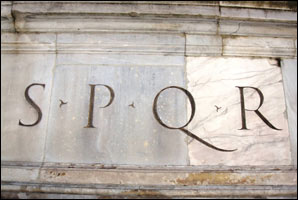 The emblem of the Republic is ubiquitous in Roma. |
|
The iconic symbol of Roma. |
Many scoffers mocked at that prophecy and believed that it could never refer to Republican Roma. Time proved them wrong however.
|
History is supposed to move FORWARD and not BACKWARD. Julius Caesar was assassinated for grasping for a crown. Roma was monarch-free for almost 1000 years before the usurpation of the Papal monarchy.
 Coat of arms of the Papal monarchy, with the triple crown, and the keys of Romulus and Remus. |
|
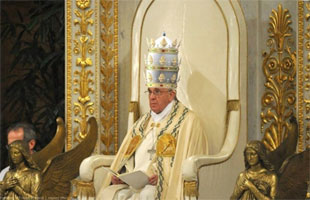 King Francis I of Argentina wearing King Francis I of Argentina wearing the triple crown. |
Until recently, the Papal monarchy was hereditary. Popes were usually "nephews" of former Popes. "Nephew" is a euphemism for "son," so "nephews" of Popes were not lying when they called their uncles "Holy Fathers."
Christ warned his followers to flee to the mountains when the abomination of desolation was set up:
When ye therefore shall see the abomination of desolation, spoken of by Daniel the prophet, stand in the holy place, (whoso readeth, let him understand). Then let them which be in Judaea flee into the mountains (Matthew 24:15-16).
The ABOMINATION OF DESOLATION is indeed the Papal monarchy . . . reigning in Republican Roma.
Then the woman fled into the wilderness, where she hath a place prepared of Elohim, that he should feed her there a thousand two hundred and sixty days (Revelation 12:6).
From that verse it is plain that the Papal monarchy should be gone with the wind after 1260 years. If we add 755 to 1260, we can see that indeed the Papal monarchy is living on borrowed time!
Vital links
References
Beeston, Edward. The Roman Empire the Empire of the Edomite. George Fox, London, U.K., 1853.
Cornell, T.J. The Beginnings of Rome. Routledge, London & New York, 2005.
Gedda, Luigi. Twins In History and Science. (Translated from Italian by Marco Milani-Comperetti).Charles C. Thomas Publishers, Springfield, Illinois, 1961.
Livy. The Early History of Rome (Books I–V). Penguin Classics, London, U.K., 1971.
Macaulay, Thomas Babbington. Lays of Ancient Rome.
Preston, Diana. Cleopatra and Antony: Power, Love, and Politics in the Ancient World. Walker & Company, New York, 2009.
